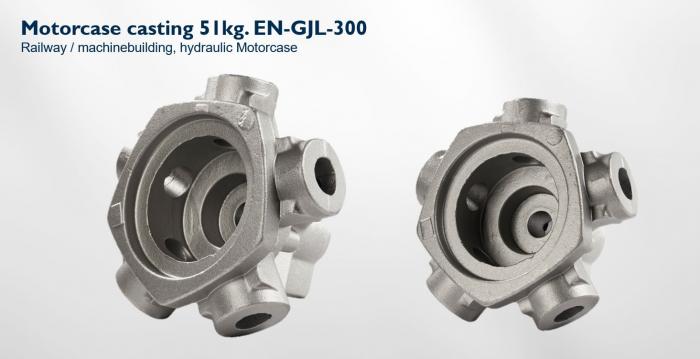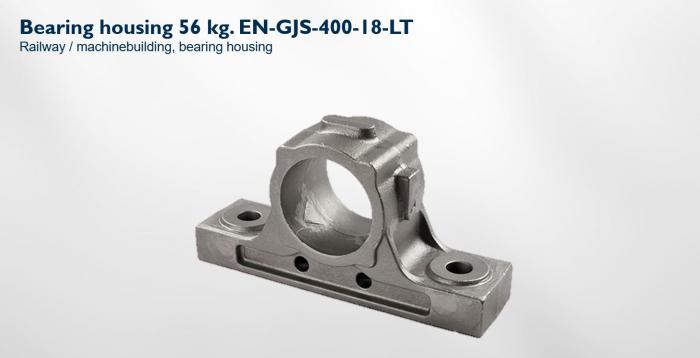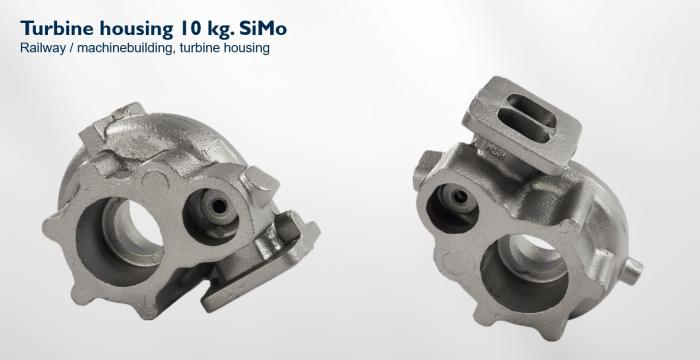Cast Iron
We manufacture castings according to EN standards EN 1561, EN 1563, EN 1564 and EN 16124. Upon request, material can also be produced according to customer specific standards or other international standards (ISO, ASTM, JIS, etc.).
Grey cast iron
Grey cast iron (according to EN 1561) is " regular " cast iron, is easy to machine, reduces noise and is relatively economical. It is named after the gray color of the fracture it forms, which is due to the presence of graphite. During solidification, the graphite forms flakes. The flakes act as internal notches reducing the tensile strength and elongation of this material. Cast iron with flake graphite has an excellent damping capacity compared to other materials and is therefore an ideal material for for instance transmission housings, cylinder blocks, machine beds and similar components. The tensile strength of cast iron with lamellar graphite is mainly determined by the size, shape and distribution of the graphite and lies between 100 N/mm² and 350 N/mm². The material can withstand significantly higher stresses under compression than under tensile load. This casting alloy is often used in mechanical engineering, but has many other applications.
Delivery program grey cast iron
EN-GJL-100, EN-GJL-150, EN-GJL-200, EN-GJL-250, EN-GJL-300, EN-GJL-350
An example

Ductile cast iron
Ductile cast iron (according to EN 1563), sometimes referred to as Spheroidal graphite cast iron has very good mechanical properties. Making it an excellent alternative to steel, even in dynamically loaded applications. This alloy is available in several qualities, from tough (ferritic) to strong and hard (pearlitic). The silicon alloyed (solid solution strengthened ferritic) grades are characterized by high elongation, homogeneous hardness independent of wall thickness and a relatively high 0.2% elongation limit in relation to tensile strength. Spheroidal graphite cast iron is a type of cast iron in which the free, unbound carbon is present in the form of nodules (spherical shapes) in the solidified cast iron. By adding alloying elements, the properties of the material can be influenced. This type of material is often used in automotive, earthmoving and machine industry.
Delivery program ductile cast iron;
EN-GJS-350-22-LT, EN-GJS-350-22, EN-GJS-400-18-LT, EN-GJS-400-18, EN-GJS-400-15, EN-GJS-450-10, EN-GJS-500-7, EN-GJS-600-3, EN-GJS-700-2
Silicon alloyed (solid solution strengthened ferritic) grades;
EN-GJS-450-18, EN-GJS-500-14, EN-GJS-600-10
An example

SiMo cast iron
SiMo spheroidal graphite cast iron (according to EN 16124), low alloyed ferritic spheroidal graphite cast iron is alloyed with silicon and molybdenum. The silicon, like in ductile cast iron, increases the strength, provides a ferritic matrix and increases the resistance to oxidation at higher temperatures by forming a protective oxide skin. The molybdenum ensures that the strength decreases less at higher temperatures, up to approximately 700 °C. The material is therefore ideally suited for the production of exhaust manifolds and turbochargers.
Delivery program SiMo cast iron;
EN-GJS-SiMo25-5, EN-GJS-SiMo30-7, EN-GJS-SiMo35-5, EN-GJS-SiMo40-6, EN-GJS-SiMo40-10, EN-GJS-SiMo45-6, EN-GJS-SiMo45-10, EN-GJS-SiMo50-6, EN-GJS-SiMo50-10
An example

ADI cast iron
Ausferritic spheroidal graphite cast iron (according to EN 1564), commonly referred to as ADI, is a low-alloy spheroidal graphite cast iron, in which the final mechanical properties are achieved after heat treatment. The material combines high strength and hardness with high elongation. ADI is widely used in mechanical engineering.
Delivery program cast iron;
EN-GJS-800-10, EN-GJS-800-10-RT, EN-GJS-900-8, EN-GJS-1050-6, EN-GJS-1200-3, EN-GJS-1400-1
